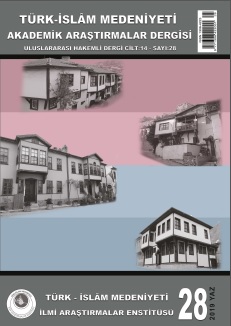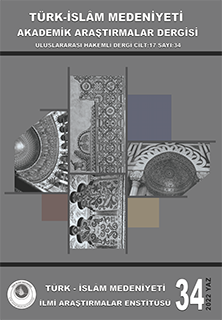Carceral Spaces in Turkey, Literature and Multiple Chronotopes (1923-1953)
Keywords:
Prison, Space, Literature, Chronotope, Symbolic InteractionAbstract
Prisons are not only places of confinement where prisoners become objects of disciplinary practices but they are also palimpsests consisting of different perceptions of time and space, a multi-layered set of historical, social and cultural reference systems, symbolic interactions, memories, individual, psychological experiences and creative imagery. This article examines the texts on the carceral experience and the perception of time-space/chronotope, by authors and poets such as Nazım Hikmet, Necip Fazıl Kısakürek, Kemal Tahir and Hasan İzettin Dinamo in Early Republican Turkey and the following years (1923-1953). It concentrates on the process of creation of carceral imagery in their texts and tries to decode the complex cultural and social systems as well as their individual experiences through a close reading and critical discourse analysis using the concepts of chronotope by Mikhail Bakthin and symbolic interaction by Erving Goffman as an analytical frame work.
References
ARTVİNLİ, F., 2013, Delilik, Siyaset ve Toplum: Toptaşı Bimarhanesi, İstanbul: Boğaziçi Üniversitesi Yayınları.
BACHOLARD, G., 2013, Mekânın Poetikası, çev. Alp Tümertekin, İstanbul: İthaki.
BAHTİN, M., 2017, Karnavaldan Romana: Edebiyat Teorisinden Dil Felsefesine Seçme Yazılar, çev. Cem Soydemir, 3. bs. İstanbul: Ayrıntı.
DİLLON, S. , 2017, Edebiyat, Eleştiri, Kuram, çev. Ferit Burak Aydar, İstanbul: Koç Üniversitesi Yayınları.
DİNAMO, H. İ., 2017, Musa’nın Hapishanesi, 2.bs. İstanbul: Tekin Yayınevi.
FAIRWEATHER, L.; McCONVİLLE S., 2003, Prison Architecture: Policy, Design and Experience, 2. bs. Oxford, Amsterdam, Boston, London: Architectural Press.
FOUCAULT, M., 2002, Kliniğin Doğuşu, Tıbbî Algının Arkeolojisi, çev. Şule Ünsaldı, Ankara: Epos.
_______, 2015, Hapishanenin Doğuşu, çev. Mehmet Ali Kılıçbay, 6.bs. Ankara:
İmge.
_______, 2016, Özne ve İktidar: Seçme Yazılar 2, çev. Işık Ergüden-Osman Akınbay, 5.bs. İstanbul: Ayrıntı.
GRAMSCI, A., 2014, Quaderni del Carcere, Volume Primo, Quaderni 1-5 (1929-1932),
Volume secondo, Quaderni 6-11 (1930-1933), Volume terzo, Quaderni 12-29 (1932-1935), Volume quarto, Aparato critico, ed. Valentino Gerratana. Torino: Giulio Einaudi editore, s. p. a.
GOFFMAN, E., 2015, Tımarhaneler: Akıl Hastalarının ve Kapatılmış Diğer Kişilerin Toplumsal Durumu Üzerine Denemeler, çev. Ebru Arıcan, Ankara: Heretik.
_______, Etkileşim Ritüelleri: Yüz Yüze Davranış Üzerine Denemeler, çev. Adem Bölükbaşı, Ankara: Heretik, 2017.
KISAKÜREK, N. F., 2016, Cinnet Mustatili, Yılanlı Kuyudan, 19.bs. İstanbul: Büyük Doğu Yayınları.
HUBARD, P.; Kitchin R., 2018, Mekân ve Yer Üzerine Büyük Düşünürler, çev. Emek Şevket Ataman, İstanbul: Litera Yayıncılık.
LEFEBVRE, H., 2014, Mekânın Üretimi, çev. Işık Ergüden, İstanbul: Sel.
MARDİN, Ş., 2006, “Cultural Change and The Intellectual: Necip Fazıl and The Nakşibendi”, Religion, Society, and Modernity in Turkey, Syracuse, New York: Syracuse University Press, s: 243-259.
MORAN, D., 2012, “ ‘Doing Time’ in Carcelar Space: Timespace and Carceral
Geography”, Geografiska Annaler, Series B, Human Geography, Vol. 94, No. 4 (December), s: 305-316.
NESİN, A., 2005, Mum Hala, İstanbul: Nesin Yayınevi.
OMAY, İ. S., 1947, Cezaevi (İş Esası Üzerine Kurulu), İstanbul: Cumhuriyet Matbaası.
(Ran), Nazım Hikmet, 2015, Cezaevinden Memet Fuat’a Mektuplar, İstanbul: Sözcükler Yayınları.
_______, 2016. Kemal Tahir’e Mahpushaneden Mektuplar, İstanbul: İthaki.
_______, 2018. Piraye’ye Mektuplar, 9. bs. İstanbul: Yapı Kredi Yayınları.
SPVAK, Gayatri Chakravorty, 2010, “Can the Subaltern Speak?”, Can the Subaltern Speak? Reflections on the History of an Idea, ed. Rosalind C. Morris. New York: Columbia University Press, s: 237-291.
TAHİR, K., 1991, Notlar/1950 Öncesi, İstanbul: Bağlam.
TARPNO, A., 2008, Geografie della memoria: Case, rovine, oggetti quotidiani, Torino:
Giulio Einaudi editore s.p.a.
YILDIZ, G., 2012, Mapushâne: Osmanlı Hapishanelerinin Kuruluş Serüveni (1839 1908), İstanbul: Kitapevi.
---------, 1932, Hapishaneler Tetkikine Ait Rapor. Umumi Hapishane Matbaası. Ankara.
Downloads
Published
How to Cite
Issue
Section
License

This work is licensed under a Creative Commons Attribution-NonCommercial 4.0 International License.







